
The Catalan Cançoner Sg
The Catalan Cançoner Sg
The Cançoner Gil or de Saragossa, known as Sg, is a Catalan manuscript that dates to the third quarter of the 14th century. It gets its name from its previous owner, Pablo Gil y Gil, a professor at the University of Zaragoza (Saragossa in Catalan). After his death, it was acquired by the Institute of Catalan Studies, thanks to donations from ten benefactors. Since then it has been held in the National Library of Catalonia, Barcelona, with the shelfmark MS 146.

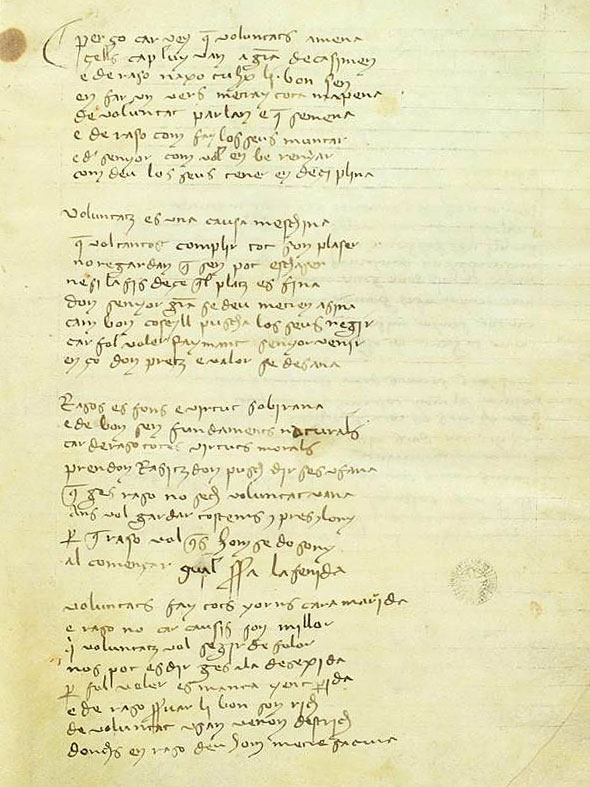
The Cançoner Sg is one of the earliest known manuscripts of poetry produced in the Catalan territories. The compiler endeavoured to gather together in a single collection works from the troubadour tradition as well as Occitan poetry of the 14th century —a rarity among surviving Occitan or Catalan manuscripts. It is also the only witness for a considerable proportion of the oeuvre of 14th-century Occitan-Catalan poets, and transmits almost the entire corpus of Cerverí de Girona’s work (104 pieces). From a material perspective, it is also a rarity: its format and quality set it apart from other later Occitan and Catalan manuscripts. This is reflected in the choice of material (vellum), in the level of decoration, and in the skill with which it was made.
The surviving part of the cançoner begins with the works of Cerverí de Girona, followed by those of the troubadours Raimbaut de Vaqueiras, Bertran de Born, Giraut de Bornelh, Arnaut Daniel, Guilhem de Sant Leidier, Bernart de Ventadorn, Pons de Capduelh, and Jaufre Rudel. Without any evident discontinuity, there are then pieces by thirteen 14th-century authors, with works by Joan de Castellnou and Ramon de Cornet being the most numerous. Following these there are four poems by Guillem de Berguedà and, finally, a fragment of the Roman de Troie by Benoît de Sainte-Maure.1 On one of the flyleaves at the back of the manuscript a second poem by Bertran de Falgar, one of the 14th-century authors, was copied a little later in a cursive hand.
What clues are there about the criteria used for the compilation and internal organisation of the manuscript? François Zufferey considers the cançoner to be divided into two parts: one collection of troubadour poetry and another of poetry from the Toulouse school. He sees the irregularity in the quire structure as marking the break between the two parts. On the other hand, Stefano Asperti argues that the cançoner is in three parts: a first section dedicated to Cerverí de Girona, a second to the troubadours, and a third to poetry from Toulouse. Following their analysis of the internal organisation of the manuscript and the decoration, Miriam Cabré and Sadurní Martí put forward a hypothesis about the choice of texts, and their placement.

The decorative programme, which prompted Asperti to define the cançoner as a single unified project, also provides some clues about the organisation of the corpus. Although the manuscript is acephalous (the beginning is missing), in the surviving part we can detect a double hierarchy, as described by Cabré–Martí: some large initials which divide the cançoner into author sections and which were never decorated, and other smaller ones which mark the beginning of a poem. The combination of a blank space and space set aside for the large main initials indicates the beginning of a section dedicated to each troubadour and divides the part containing the 14th-century poets into five. A rubric in red ink usually precedes each piece and the lines of verse, generally copied out in running text, are separated by fullstops.
The decorated initials that mark the start of each piece come to a halt on folio 39r and after folio 127v there is no use of coloured ink whatsoever. The 106 initials in the first four quires were decorated by the same miniaturist; a second hand added two more in a different style on two folios that had no other decoration.
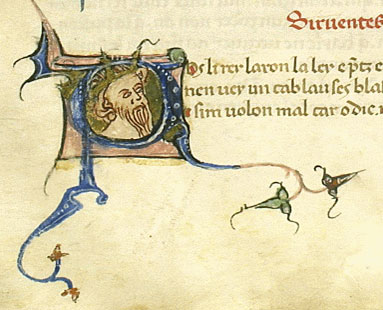
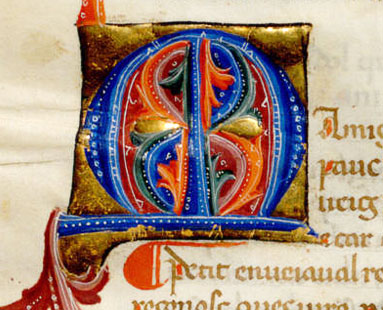
We can see the two types of miniatures: the first is by the main miniaturist (f. 12v), and the second added by the other miniaturist (f. 49v), only two of whose decorated initials survive in the manuscript.
.jpg)
Comparison (from left to right) between the miniatures from the Usatges de Lleida (Lleida Cathedral, MS 28), Cançoner Sg, and the Breviari d'amor in St Petersburg (National Library of Russia, MS prov. F. XIV. 1).

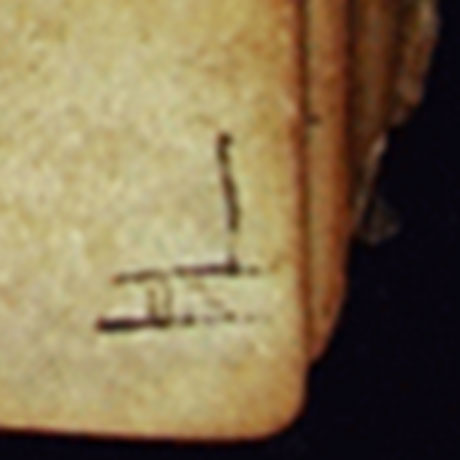
The quire signatures (signs marking the beginning or end of a gathering) also indicate that the Usatges de Lleida manuscript and Cançoner Sg are from the same scriptorium.
The decorated initials by the principal miniaturist are French Gothic, a style that originated in biblical manuscripts and went on to acquire an international character, as evidenced by their presence in hundreds of 13th- and 14th-century manuscripts. The colours are opaque and there is an alternation between red and blue for the lettering and the background. Following an observation by Pere Bohigas on the similarity between the initials by the main decorator and those found in the Usages et constitutions de Catalogne, held in Lleida Cathedral (MS 28), together with studies on a group of manuscripts of legal texts which feature the same type of initials, Cabré–Martí identified two manuscripts from the same scriptorium as Cançoner Sg, very probably linked to the University of Lleida: the Usatges and a Breviari d’amor, currently held in the National Library of Russia, St Petersburg, MS prov. F. XIV. 1. The initials on folios 49v–50r, drawn by the second miniaturist, belong to the iconographic style of the court of King Pere the Ceremonious, in a clearly Italianate style.
The Cançoner Sg has 128 folios measuring 232 x 315 mm, in 14 quires of [(5+5) quinions], some fragmentary. There are also other losses in the manuscript: the cançoner is acephalous, and so twelve folios that would correspond to the first (missing) quinion, plus two from the extant first quire, are missing. Another point worth highlighting affects the poem “Si co’l vassayl can servex longamen” by Tomas Peris de Foces, copied on the current folio 116r but with the rubric at the foot of folio 123v. Zufferey indicates that quire 13 is folded the wrong way round, and Cabré–Martí add that the outer folio is missing. Once the folios have been re-ordered, the attribution reappears as the rubric now precedes the poem. Furthermore, the integrity of the piece "Trop home son part de ver lauzador” by Guillem de Borzach, which was missing its ending, is also resolved. However, there are problems with quire 14 too. Unlike Zufferey and Simone Ventura, Cabré–Martí resolve this by presenting it as a fragmentary quinion which re-establishes the coherence of the manuscript. This is indicated by the fact that the five surviving folios were perforated together, and so formed part of a single quire.
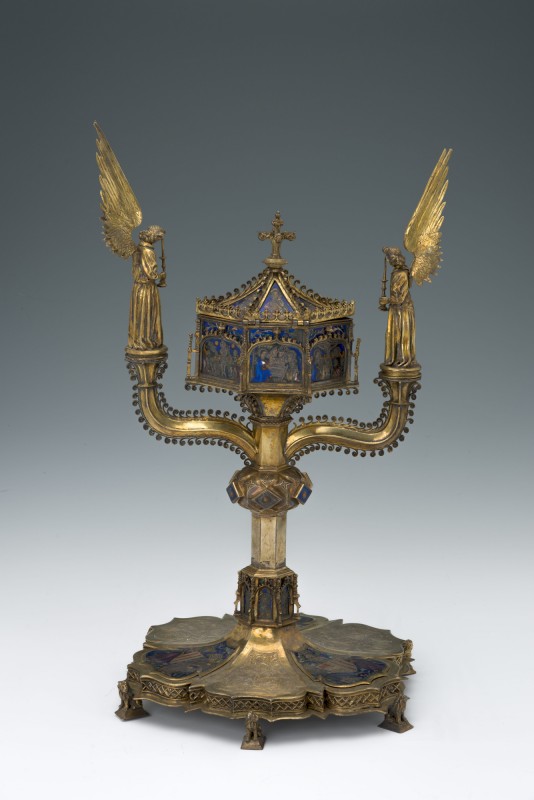
To find a possible sponsor behind Cançoner Sg, Cabré–Martí focus on the relationships between the poets and the nobility —as well as other factors like literary characteristics, bibliographical information about the authors, components of the pagination, and compilation criteria. The figure of Tomas Peris de Foces is worthy of a special mention: as well as being the only poet in the cançoner who was apparently foreign to the Toulouse tradition, he occupies a privileged position within the anthology. The political connotation of the piece “Trop me desplay can vey falir” allows us to place the author in the context of the conflict between King Pere the Ceremonious and the Uniones in the closing months of 1347. The Catalan-Aragonese royal court, a promotor of culture and with close ties to the troubadour tradition, would seem to be the most plausible environment for the compilation —as had been suspected— but the decoration in Cançoner Sg differs from that found in manuscripts collected by this king. Cabré–Martí connect the cançoner instead with the family of Jaume, Count of Urgell, well known as a patron of the arts. His wife, Cécile de Comminges, belonged to a family associated with supporting poetry. Furthermore, Joan de Castellnou, Ramon de Cornet, and Bertran de Falgar (in a piece that was added later, as we have seen above) dedicate poems to the Occitan-Catalan high nobility, including Jaume of Urgell and his wife. Cabré–Martí believe that the most likely candidate would therefore be Pere II of Urgell, the son of Jaume of Urgell, an important art collector and bibliophile. It is also worth bearing in mind that Lleida was close to the county capital of Balaguer, where Pere lived for a long time. And finally his first wife, Beatriu de Cardona, belonged to the family to which Cerverí dedicates the vast majority of his poems: Beatriu could perhaps have sponsored, together with Pere, the production of the cançoner, and her death in 1375 could explain, very hypothetically, the interruption in the decoration of Cançoner Sg.
Laura Gallegos Ambel
Bibliography
Asperti, Stefano (1958): «Flamenca e dintorni: considerazioni sui rapporti fra Occitania e Catalogna nel xiv secolo», Cultura Neolatina, 45, 59 – 102.
Cabré, Miriam i Sadurní Martí (2010): «Le Chansonnier Sg au carrefour Occitano-Catalan», Romania 128, 92-134.
Ventura, Simone (2006 [2009]): Intavulare. I. Canzoneri provenzali. 10. Barcelona, Biblioteca de Catalunya (Sg) 146, Modena: Mucchi.
Zufferey, François (1981): Bibliographie des poètes provençaux des XIVe et XVe siècles. Genève: Droz.
